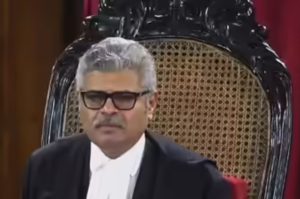Calcutta High Court Chief Justice: In a powerful farewell address, Chief Justice T. S. Sivagnanam of the Calcutta High Court drew attention to the persistent challenges faced by the judiciary—judicial vacancies, case backlogs, excessive workloads, and long working hours. His remarks, delivered during his last official function, went beyond personal reflection and served as a cautionary note about the systemic strain affecting one of India’s oldest and most respected High Courts.

With over 2 lakh pending cases and nearly half the sanctioned judicial strength lying vacant, the Chief Justice underscored how mounting workload burdens threaten the promise of speedy justice and can erode public trust in the judicial system.
Chief Justice Sivagnanam’s Key Concerns
1. Judicial Vacancies
The Calcutta High Court currently operates with 24 vacancies, leaving just 48 judges to handle the caseload of one of the busiest courts in the country. To address this, the High Court collegium has recommended 17 names for appointment. The outgoing Chief Justice expressed hope that even if 10 are cleared, it would significantly ease the burden.
🔗 Department of Justice, Government of India – Judicial Vacancies
2. Case Backlog
With over 200,000 cases pending, including second appeals delayed by 25–30 years, the CJ emphasized that clearing old cases must become a top priority. Such delays, he warned, threaten the constitutional guarantee of timely justice.
🔗 National Judicial Data Grid – Case Statistics
3. Extended Working Hours
CJ Sivagnanam revealed that many judges of the Calcutta HC, particularly those in division benches, often work till 8:30 PM and still carry additional case lists. Judges regularly handle three to four extra determinations to ensure hearings continue without collapse under the weight of backlog.
While this demonstrates the dedication of the judiciary, the Chief Justice stressed that long hours are not sustainable and could compromise the quality of judgments.
4. Transparency and Live Streaming
One of the achievements during his tenure was the expansion of live-streamed hearings, which has brought greater transparency to judicial functioning. The Calcutta High Court even received a YouTube Silver Button for its outreach, symbolizing the growing popularity of digital court access.
🔗 Calcutta High Court – Official Website
5. Missed Elevation and Reflections
While reflecting on his career, Justice Sivagnanam mentioned that he had once been considered for elevation to the Supreme Court but did not dwell on it, stating he had “no regrets.” Instead, his focus remained on institutional reforms and unfinished work within the High Court system.
Calcutta High Court Chief Justice: Broader Judicial Context
A Nationwide Problem
The crisis at the Calcutta High Court mirrors challenges across India. Vacancies in High Courts often hover between 30–40% of sanctioned strength. The Supreme Court Collegium, which recommends appointments, has repeatedly called for faster clearance of names by the government to prevent justice from stalling.
🔗 Supreme Court of India – Collegium Resolutions
Impact on Litigants
- Justice Delayed: For thousands of litigants, delayed hearings mean prolonged uncertainty in civil, criminal, and family disputes.
- Economic Impact: Businesses face financial losses when commercial disputes remain unresolved for decades.
- Social Consequences: Families in succession, property, or custody battles suffer generational damage due to delayed verdicts.
Judge Workload & Burnout
Legal experts warn that overburdened judges may face stress and fatigue, potentially affecting the depth of judicial reasoning. Prolonged workdays also create health and morale issues among the judiciary and court staff.
The Way Forward
The Chief Justice’s farewell message indirectly laid out a roadmap for reform:
- Expedite Appointments – Faster government approvals on collegium recommendations.
- Digitization – Broader adoption of e-filing, e-courts, and digital records to save time.
- Alternative Dispute Resolution (ADR) – Mediation and arbitration must be encouraged to reduce load on courts.
- Infrastructure Development – More courtrooms, support staff, and research assistance for judges.
- Workload Management – Balanced assignment of cases across benches to avoid overburdening a few.
🔗 Ministry of Law & Justice – Judicial Reforms
Transition of Leadership
With Justice Sivagnanam’s retirement, Justice Soumen Sen assumes charge as Acting Chief Justice of the Calcutta High Court. However, the Supreme Court Collegium has recommended his transfer to head the Meghalaya High Court. If that happens, Justice Sujoy Paul is expected to become the senior-most judge in Calcutta.
This leadership change will test whether the pressing issues raised by the outgoing CJ receive timely attention.
Public and Expert Reactions
- Legal Fraternity: Senior advocates welcomed the CJ’s candor, calling his speech a “wake-up call.”
- Academics: Law professors highlighted the urgency for UGC-guided legal education reforms to produce better-trained lawyers and judicial officers.
- Civil Society: Activists have urged both the Union Government and the State Government to collaborate in strengthening the justice delivery system.
🔗 University Grants Commission – Higher Legal Education
Conclusion
The farewell speech of Calcutta High Court Chief Justice T. S. Sivagnanam was more than a ceremonial address. It was a candid assessment of the challenges facing the judiciary today—chronic vacancies, massive case backlogs, overworked judges, and the urgent need for systemic reform.
As India’s judiciary continues to be the last resort for millions seeking justice, his words resonate as both a warning and a roadmap. For litigants waiting decades for resolution, for lawyers balancing slow processes, and for judges stretched beyond limits, the time for change cannot be postponed any longer.
The baton now passes to new leadership, but the responsibility lies with the judiciary, the executive, and society at large to strengthen one of democracy’s most vital institutions—the courts.
🔗 Official & Government Sources for Reference:
- Calcutta High Court
- Department of Justice, Government of India
- National Judicial Data Grid
- Supreme Court of India – Collegium Resolutions
- Ministry of Law & Justice
Also read: Home | Channel 6 Network – Latest News, Breaking Updates: Politics, Business, Tech & More

